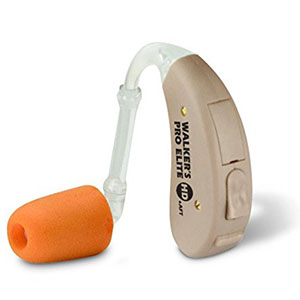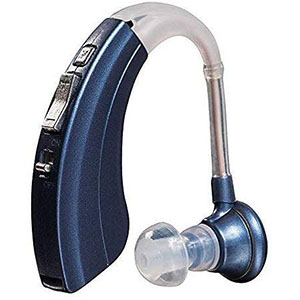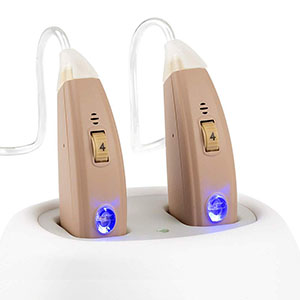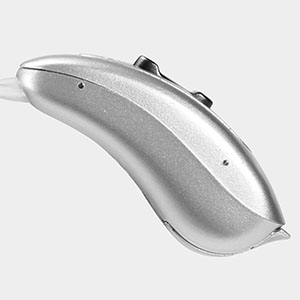Hearing aids are small medical devices that fit over and into the ear gathering, processing and amplifying sound.
Hearing aids are used by people who have suffered various degrees of hearing loss and allows them to enjoy something like normal hearing again.
Our experts have compiled the following list of the best hearing aids for 2023.
Rankings
1. Walkers Game Ear Elite Digital HD PRO 2

Click here for the lowest price on Amazon
It won’t win ‘most beautiful hearing aid’ but the Walkers Game Ear Elite will provide beautiful, well-rounded sound for those with mild to moderate hearing loss. Programming this puppy may take some practice, but it’s well worth it.
What we like: This tiny device offers a level of hearing assistance that belies its size. The 20 bit audio processor and automatic feedback control produce nice clean sound at every point on the spectrum. One of the most versatile and effective of the new generation of digital hearing assistants.
Flaws: Some folks say the tips wear on them a bit after a few hours.
2. Britzgo Digital Hearing Aid

Click here for the lowest price on Amazon
The dark blue color is a bit conspicuous. But if you don’t mind advertising that you’re wearing a hearing aid you’ll enjoy how effective the Britzgo Digital Hearing Aid is. It’s well-built, can be shifted from ear to ear and does a good job filtering out white noise.
What we like: The company may not be a household name, but the Britzgo Hearing Aid provides rich, high-end sound quality nonetheless. It’s a wee bit indiscreet. But once you turn it on we doubt you’re going to care much what it looks like.
You’ll get 500 hours out of the battery and whistle-free sound up and down the spectrum. It’s equally effective in either ear. So if one gets tired just switch to the other.
Flaws: Some say it’s too easy to accidentally hit the control buttons.
3. EARGO Neo Virtually Invisible Hearing Aid

Click here for the lowest price on Amazon
Eargo Neo is easily adjustable, light and comfortable. The company takes a slightly different approach to harvesting sound, focusing on sounds emanating from the front rather than the back.
What we like: Eargo Neo hearing aids are nearly invisible. They slip into your ear and go to work discreetly restoring your sense of hearing. We appreciate the range of sound profiles they offer and the fact that they weigh almost nothing.
Flaws: May not be helpful for those with severe hearing loss.
4. Siemens Signia Run Hearing Aid

Click here for the lowest price on Amazon
The uninspired profile of the Siemens Signa Run should not distract from the job it does for those with mild to moderate hearing loss. It captures sound from all angles and is fully adjustable for treble, bass and volume. Recommended for those with serious tinnitus.
What we like: We appreciate the fact that the engineers paid special attention to the ‘own voice’ issue. They do a good job minimizing tinnitus symptoms and the 8 channels produce rich, textured sound. The ability to capture sound in 360 degrees is also a big plus.
Flaws: It can take a while to adjust them for optimal results. That and the fact that the battery is not rechargeable.
5. Neosonic MX Rechargeable Hearing Aid

Click here for the lowest price on Amazon
Light, effective and rechargeable. That pretty much describes the Neosonic MX. The lithium-polymer battery can be topped-up 500 times, it comes with a handy charging port and and the front and back mics pick up a full array of sounds.
What we like: A big pat on the back for having a rechargeable battery. In 2020 it should be standard fare, not an exception. The dual mic setup captures a nice balance of sound from front and back while the ‘ear dome’ fits into the ear nice and snug.
The ability of the device to filter out white noise is pretty impressive and the 50db upper limit is enough to tackle moderate hearing loss.
Flaws: Hard to find fault with these. But if we had to nitpick we might mention the noise filtering is not as comprehensive as the marketing makes it out to be.
6. Otofonix Elite Hearing Amplifier to Assist and Aid

Click here for the lowest price on Amazon
A decade ago the Otofonix Elite would have been considered revolutionary. Today it’s a nice mid-level hearing aid for those suffering from mild hearing loss. Very easy to program and adjust it takes a lot of the guesswork out of the hearing aid.
What we like: This is a very lightweight and discreet hearing aid/amplifier. It tucks in effectively behind the ear and produces whistle-free sound at any volume. We also appreciate the 4 preset audio programs.
The 45 day trial offer is a nice thing to have and makes purchasing the Otofonix Elite essentially a no-lose proposition.
Flaws: Opening the battery compartment can provide something of a challenge, especially if you suffer from arthritis.
7. Life Ear Empower Hearing Amplifier

Click here for the lowest price on Amazon
The Life Ear Empower is very thin and light and quite effective. It’s highly adjustable, although it will require a bit of patience to master the different aspects of the control programs. It’s particularly effective picking up and boosting low and subtle sounds.
What we like: We like that it’s very lightweight and discreet and that it’s available in several colors. We like that the 12 band processing is so effective at cleaning up the sound it presents. We also appreciate the 1 year warranty and that the company provides 8 batteries. The carrying case is pretty nice too.
Flaws: Really wish it used rechargeable batteries. And the color choices are so-so at best.
8. FIIL-G2090 Hearing Aid/Amplifier

Click here for the lowest price on Amazon
The G2090 tucks in neatly over the ear and basically disappears into the background while helping you pick up sounds you may have been missing for years. Unlike most other assistive devices for hearing it’s available in 3 different sizes. It also offers an array of useful presets. So you don’t have to be an engineer to use it.
What we like: With 16 volume settings and 4 presets it’s sure to fill the needs of just about anyone with mild to moderate hearing loss. The ear domes also come in 3 sizes to help provide a snug fit and it’s light enough to be forgettable.
The device features outstanding build quality and reasonably long battery life. You can also return it within 30 days if you’re not happy.
Flaws: The very prominent control buttons are just waiting for you to accidentally hit them with a finger, comb or brush.
9. Banglijian Hearing Aid and Amplifier

Click here for the lowest price on Amazon
The Banglijian Hearing Aid/Amplifier charges from spent in less than 4 hours. That full charge will provide you with a whole day of use. You can adjust for quiet or noisy environments and it’s available with either a thin or thick sound tube, depending on your needs.
What we like: While the FDA won’t technically recognize this as a hearing aid, that’s exactly what it is. And a darn good one at that. We like the rich and full sound quality, the easy adjustment and that the batteries are rechargeable.
We also appreciate the auto off feature once the device is fully charged, the comfortable fit and the 3 year limited warranty.
Flaws: You might experience a bit of whistling in noisy environments. It also has an insubstantial feel to it. Though that’s by design no doubt.
10. MSA 30X Rechargeable Hearing Aid

Click here for the lowest price on Amazon
The last of our best hearing aids is the MSA 30X Rechargeable. This little device has a lot going for it including rechargeability, light weight, full-bodied sound and an attractive price point. It also comes as a pair rather than a single unit. So those who looking for more than single ear hearing assistance, here it is.
What we like: We like that the devices hold onto your ears nice and firm. That they produce clear, feedback-free sound. We like that they do a good job filtering out white noise and that there are two of them.
Other big pluses include fast recharging, the fact that they provide 6 tips and that they’re so affordable.
Flaws: Not for people with moderate to severe hearing loss. And not the most discreet hearing aids on the market.
Who Needs Hearing Aids?
Nearly 50 million Americans are thought to suffer from some form of hearing loss. And while many of those cases occur in people over the age of 60, seniors are not the only ones to suffer from this vexing condition. Soldiers often return home from the front lines suffering varying degrees of hearing loss. Factory workers, construction workers and – more often than most people realize – rock musicians (1) also fall victim to hearing loss.
But while hearing loss is commonly associated with the above high-risk groups anyone can wind up losing their hearing in part or in whole. And this is especially true for people who live in urban settings where noise from the street is often unrelenting.
How We Ranked
It’s not necessary to get a doctor’s prescription to buy a hearing aid. But it doesn’t hurt to have a hearing test and discuss the results with your doctor before you do. Once you purchase your hearing aid you may find you need some help adjusting it so that you can make optimal use of it. An audiologist (2) can help you through the adjustment process.
When choosing devices for our list we applied various criteria including whether they were digital or analog. Many of the best hearing aids are still analog. But digital devices have made rapid progress in recent years and now are considered equal to, and in some cases better than, the best analog hearing aids.
We also considered the size of the various devices. These should be fairly discrete devices that slip over or into the ear without calling undue attention to themselves. So if there were two devices that were otherwise equal in performance but one was smaller and lighter than the other, we chose the smaller, lighter option.
We also considered how well the hearing aids filtered out background noise. Muddiness has been and continues to be a significant challenge for hearing aid manufacturers. So the better a particular device was/is at filtering out aural pollution the more likely it was to make our list.
Finally, we looked at additional features such as directional microphones that help you distinguish one voice from another in a crowd, Bluetooth compatibility, whether a pair of digital hearing aids can be synced together as well as the IP rating. The IP rating indicates how well a particular hearing aid prevents water and dust from infiltrating and messing things up.
FAQs
Q: Will a hearing aid fix my hearing problem?
A: A hearing aid will improve your ability to hear while you are wearing it. They do not however, ‘fix’ the cause of the hearing loss. There are surgical remedies available today that can and do provide either partial or complete fixes for some types of hearing loss. Cochlear Implants are one such remedy (3). Bone anchored hearing systems (4) are another surgical method for restoring some or most of a person’s lost hearing.
Q: Is it difficult to adjust a hearing aid?
A: That will depend on how severe your hearing loss is and the type of hearing aid involved. One of the most common problems experienced by those who wear hearing aids is that the sound of their own voice can often interfere with their perception of other sounds. These ‘own voice’ issues (as they’re known) have a number of possible causes (5). If you experience this problem it’s a good idea to see an audiologist who may be able to make adjustments to the hearing aid.
Q: Will Medicare pay for my hearing aid?
A: Medicare does not cover hearing aids. However, there are some Medicare Advantage (6) plans that may. If you have Medicare Advantage you need to check the fine print on your plan to find out if it will cover the cost of a hearing aid. Certain types of Special Needs Plans may. Keep in mind too that if you’re a veteran you may be able to obtain a hearing aid at little or no cost through the VA (7).
Q: How do I know if I need a hearing aid?
A: In some cases hearing loss can come on so gradually a person may not be aware they are suffering hearing impairment until something happens. Maybe they find themselves asking others to repeat what they say. Or maybe they find themselves having to turn up the TV in order to hear clearly. If you are unsure whether the problem is with the TV or your hearing it’s a good idea to go to the doctor and get a hearing test. It doesn’t cost much and dealing with hearing loss sooner rather than later can prevent potentially serious problems later in life.
Q: Is it safe to buy hearing aids online?
A: Sure. But in order to be certain you get the right one, it’s a good idea to visit your doctor before you do. Get your hearing examined and ask the doctor to recommend a type, size and perhaps a particular brand before heading online to make the purchase. This will greatly increase your chances of finding one that will be effective for you. Otherwise you are just feeling your way in the dark hoping you find something that works. And that’s a good way to waste time and money.
Q: Why doesn’t everyone wear two hearing aids?
A: In some cases a person may only be suffering hearing loss in one ear. This is not an uncommon situation (8) and may stem from a congenital condition or some environmental factor like shooting a firearm without proper ear protection. That said, if a person has more or less equal hearing loss in both ears it would certainly be in their interest to wear two hearing aids. What may be stopping them is the cost.
Q: What is a ‘digital’ hearing aid?
A: A digital hearing aid is one that puts received sound waves through an algorithm to determine its precise properties before deciding the right way to amplify it for human consumption. The integration of digital technology into hearing aids is one of several advances in hearing aid technology that have emerged in recent years (9). There are many who believe digital hearing aids to be superior to older analog hearing aid technology.
Q: Do all hearing aids have rechargeable batteries?
A: While rechargeable batteries are becoming more common in hearing aids they have not yet become the default choice for many manufacturers. This is mostly due to the costs related to having to retrofit existing devices with a new type of power source. It is likely however, that in the not-too-distant future most hearing aids will use rechargeable batteries as those older devices are gradually replaced in the marketplace.
Q: How long does a hearing aid last?
A: Most can be expected to last anywhere from 5 to 10 years or so. Keep in mind though that hearing aid technology is advancing rapidly along with just about everything else. So if you drop a lot of money on a high-end device today it may well be obsolete 2 or 3 years from now. It’s also likely that, just like the price of HDTVs has dropped dramatically in recent years, the price of high-end digital hearing aids will also be coming down in the near future.
Do hearing aids require a lot of maintenance?
A: Most hearing aids do not require what any car or house owner would recognize as ‘maintenance’. Essentially, all you need to do is keep your hearing aid clean, store it properly and change the batteries when they die. (Or recharge them if you use rechargeable batteries.) Most high-quality hearing aids will come with a warranty that protects you against defects in workmanship or parts and will cover the cost of repairs or replacement. As hearing aids are not cheap you should always be sure the one you want comes with such a warranty.
Q: Will a hearing aid cure my tinnitus?
A: It is believed that nearly 20% of people over the age of 60 experience some degree of tinnitus (10). Hearing aids have demonstrated an ability to reduce some of the more odious symptoms of tinnitus. For instance, they make it much easier to differentiate between sounds and they can reduce the amount of ringing a person hears while the hearing aid is in place.
Q: Are PSAPs the same as hearing aids?
A: The PSAP amplifies sound by way of a series of microphones and presents the amplified sound to your ears. Like modern headphones many of these devices are also Bluetooth enabled and can be used to stream audio. Those arguing against classifying PSAPs as hearing aids are having an increasingly difficult time justifying their position. And the day is no doubt close at hand when all such devices will be able to call themselves hearing aids.
Q: Are hearing aids expensive?
A: Hearing aids don’t cost nearly as much as they used to. But they’re still not cheap. Some PSAPs won’t cost more than 20 dollars. But more involved hearing aids, even the new, digital models, will typically cost way more than that. Some of them will tip over into 4-figure territory. But those are more the exception than the rule these days. It’s likely that in the coming years the price of hearing technology will drop significantly while at the same time the quality will improve significantly.
Related Articles
Recap
Today, digital technology makes it possible for hearing aids to capture and process noise, analyze it, clean it up and present it to your ear in near real-time. And with hearing amplifiers getting more sophisticated by the day the future looks bright for those in need of help with their hearing loss.
For cpoe.org’s #1 recommended hearing aid, click here.

